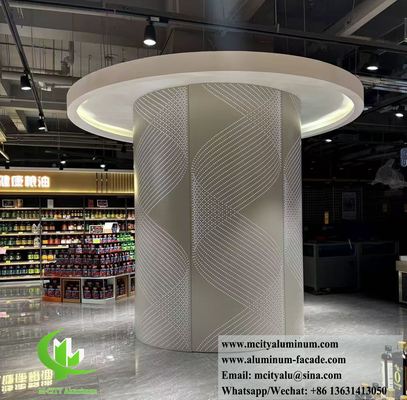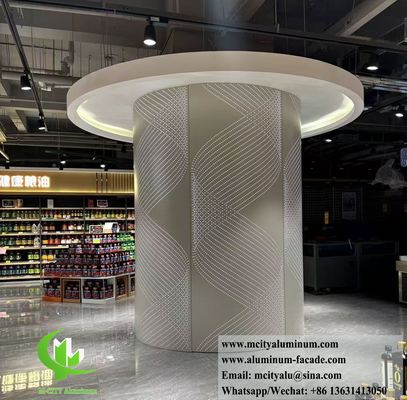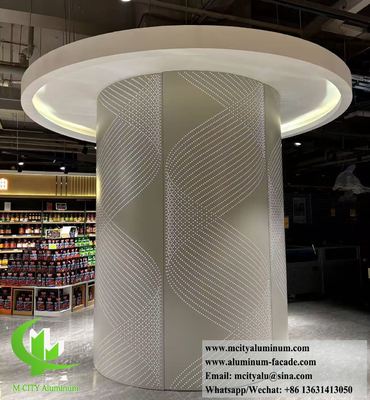Professional Description of Aluminum Column Cladding
Aluminum column cladding stands as a pivotal innovation in the field of architectural exterior and interior design, serving as a high-performance, versatile solution for enhancing the aesthetic appeal, structural protection, and functional durability of columns in both commercial and residential buildings. As a specialized cladding system tailored explicitly for column structures, aluminum column cladding integrates advanced material science, precision engineering, and architectural aesthetics to meet the evolving demands of modern construction projects—from high-rise office towers and luxury hotels to heritage building renovations and contemporary residential complexes.
At the core of aluminum column cladding’s superiority lies its premium material composition. Crafted from high-grade aluminum alloys, typically 3000-series or 5000-series aluminum, this cladding material offers an exceptional balance of strength, lightweight properties, and corrosion resistance. Unlike traditional cladding materials such as steel, wood, or stone, aluminum column cladding eliminates the risk of rust, rot, or degradation caused by harsh environmental conditions, including extreme temperatures, heavy rainfall, high humidity, and UV radiation. The aluminum substrate undergoes a series of advanced surface treatment processes to further enhance its performance: anodization creates a durable, scratch-resistant oxide layer that preserves the cladding’s color and finish for decades; powder coating, available in a vast spectrum of RAL or Pantone colors, provides a smooth, uniform surface with excellent adhesion and resistance to chipping, fading, and chemical damage; and fluorocarbon coating (PVDF) elevates the cladding’s durability to industrial-grade standards, making it suitable for coastal areas with salt-laden air or regions with high pollution levels. These surface treatments not only extend the lifespan of aluminum column cladding—often exceeding 25 years with minimal maintenance—but also allow architects and designers to unleash creative freedom, matching the cladding’s appearance to the overall design language of a building, whether it be sleek and modern, warm and rustic, or classic and timeless.
In terms of structural design and engineering, aluminum column cladding is engineered to deliver both form and function. The cladding system consists of prefabricated panels, custom-fabricated to fit the specific dimensions and contours of columns—whether they are round, square, rectangular, or irregularly shaped. This prefabrication process ensures high precision, consistent quality, and efficient on-site installation, reducing construction time and labor costs. The panels are designed with a modular structure, featuring interlocking edges or hidden fastening systems that create a seamless, visually appealing surface while ensuring secure attachment to the column substrate. Additionally, aluminum column cladding can be integrated with thermal insulation layers (such as mineral wool or foam insulation) and vapor barriers, transforming the cladding into a thermal envelope that enhances the building’s energy efficiency. By reducing heat transfer through columns, the cladding helps maintain stable indoor temperatures, lowers heating and cooling costs, and contributes to the building’s compliance with green building standards such as LEED or BREEAM.
Performance-wise, aluminum column cladding excels in multiple critical areas that are non-negotiable in modern construction. Its lightweight nature—aluminum has a density of just 2.7 g/cm³, significantly lower than steel (7.85 g/cm³) or stone—reduces the structural load on the building, eliminating the need for additional structural reinforcement and making it an ideal choice for retrofitting existing buildings or constructing structures with weight-sensitive designs. In terms of fire resistance, aluminum column cladding performs exceptionally well: aluminum has a high melting point (660°C) and does not burn, and when combined with fire-retardant insulation, the cladding system can achieve fire ratings of up to 2 hours or more, providing valuable time for evacuation and fire suppression in case of emergencies. The cladding’s resistance to impact and mechanical damage is another key advantage; the rigid aluminum panels, reinforced by internal ribbing or backing plates, can withstand accidental collisions, wind loads, and even minor vandalism without sustaining permanent damage. Moreover, aluminum column cladding is highly weather-resistant, maintaining its structural integrity and aesthetic appeal even in extreme weather events such as hurricanes, heavy snowfall, or intense sunlight.
The application scope of aluminum column cladding is remarkably broad, spanning diverse architectural sectors and design styles. In commercial buildings, such as shopping malls, office towers, and convention centers, aluminum column cladding is used to create a sophisticated, professional appearance that aligns with the brand identity of the building. For example, in a modern office tower, sleek, anodized aluminum column cladding in a metallic silver finish can complement the building’s glass curtain wall, creating a cohesive, futuristic look. In hospitality settings, such as luxury hotels or resorts, aluminum column cladding can be customized with wood-grain powder coating to mimic the warmth of natural wood, adding a touch of elegance and comfort to lobbies, corridors, and outdoor terraces. In heritage building renovations, aluminum column cladding offers a non-intrusive solution to protect historical columns while preserving the building’s original aesthetic—since the cladding can be custom-colored and shaped to match the historical details, it ensures that the building’s cultural heritage is respected while enhancing its durability. Even in residential buildings, aluminum column cladding is gaining popularity, used in entryways, patios, or interior columns to add a touch of modernity and luxury to homes.
Installation and maintenance of aluminum column cladding are designed to be user-friendly and cost-effective, further enhancing its appeal to contractors, building owners, and facility managers. The modular design of the cladding panels allows for quick and straightforward installation: after the column substrate is prepared (cleaned, leveled, and, if necessary, primed), the panels are attached using concealed fasteners or adhesive systems, with minimal on-site cutting or adjustment required. This not only speeds up the installation process but also ensures a clean, unobtrusive finish with no visible hardware. Maintenance requirements for aluminum column cladding are extremely low: the smooth, non-porous surface of the cladding resists dirt, dust, and grime, and can be cleaned with just mild soap and water, eliminating the need for expensive cleaning chemicals or specialized maintenance equipment. Unlike wood cladding, which requires regular painting or staining, or steel cladding, which needs anti-rust treatments, aluminum column cladding retains its appearance and performance with minimal upkeep, reducing long-term maintenance costs and hassle for building owners.
Sustainability is another key highlight of aluminum column cladding, aligning with the global trend toward eco-friendly construction. Aluminum is one of the most recyclable materials in the world, with a recycling rate of over 90%—far higher than most other construction materials. The production of recycled aluminum requires only 5% of the energy needed to produce primary aluminum, significantly reducing carbon emissions and environmental impact. Many manufacturers of aluminum column cladding source their aluminum from recycled materials, and the cladding itself is fully recyclable at the end of its lifespan, making it a closed-loop, sustainable solution. Additionally, the energy efficiency benefits of aluminum column cladding—reducing a building’s energy consumption for heating and cooling—further contribute to its environmental credentials, helping building owners reduce their carbon footprint and achieve their sustainability goals.
In conclusion, aluminum column cladding is more than just a decorative element for columns—it is a high-performance, versatile, and sustainable building solution that combines aesthetic excellence, structural protection, and functional durability. Its premium aluminum composition, advanced surface treatments, precision engineering, and broad application scope make it an indispensable choice for modern architectural projects, whether they are focused on luxury, efficiency, sustainability, or historical preservation. As the construction industry continues to evolve, aluminum column cladding will undoubtedly remain at the forefront of innovation, setting new standards for quality, performance, and design in column cladding systems.


FAQ
|
1: Are you trading company or factory?
We are 100% professional manufacturer, more than 50 producing machines, with more than 100 staffs.
|
|
2: Can you accept our own designs?
Yes. Size, color, patterns/designs can be customized as per your project requirements.
|
|
3: What is your MOQ order?
We accept small order also, MOQ is 80sq.m
|
|
4: what is the delivery time?
It will be finished within 30days after received the deposit.
|
| |
| Materials: |
Aluminum alloy 1100 /3003 series |
| Standard size: |
1000mmx2000mm |
| Other size: |
Max. Width: 1200mm Max. Lenght: 5000mm |
| Thickness: |
1mm--10mm |
| Surface treatment: |
Powder coated, PVDF paint |
| Color: |
Any RAL colors, wooden grain color, stone color, etc. |
| Coating: |
Akzo Nobel, PPG, etc. |
| Application: |
Facade, fence, wall canopy, ceiling, screen, window, balcony, privacy panel, space dividers etc. |
| Patterns |
Any patterns can be made, just supply us the drawing or picture |

 Your message must be between 20-3,000 characters!
Your message must be between 20-3,000 characters! Please check your E-mail!
Please check your E-mail!  Your message must be between 20-3,000 characters!
Your message must be between 20-3,000 characters! Please check your E-mail!
Please check your E-mail! 


